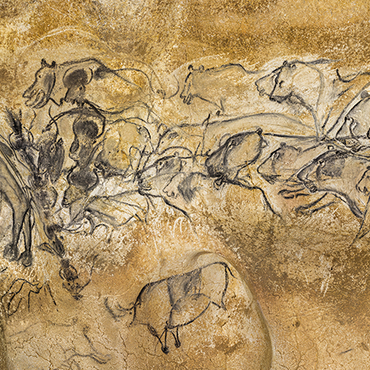
- Home
- Discover the cave
- Humans of Chauvet-Pont d'Arc
- Aurignacian cave art
The cave became famous for the aesthetic quality of its works and their age: two major periods of occupation were revealed by 82 radiocarbon dates. The earliest human use of the cave, around 36,500 years ago, falls within the Aurignacian period, and the most recent between 30,000 and 31,000 years ago, in the Gravettian period. The convergence of the results obtained in several research fields (palaeontology, geology, archaeology, various dating techniques) makes Chauvet not only the most dated decorated site but also the best dated in the world.
Themes
Among the 435 animal images discovered, mammoths, felines, rhinoceros and bears represent almost 65% of the identifiable species. These formidable animals, generally not hunted, were later to become a minority subject in cave art. The other species depicted are horse, bison, aurochs, ibex, deer (including megaloceros), reindeer and very occasional images of muskox, owls, panthers and possibly hyenas.
The human themes include the lower body of a woman, associated with a bison and a feline, several sets of female genitals, and red hands, both positive and negative. Multiple large dots, made with the palm of the hand covered in paint, constitute one of the original features of the cave.
Techniques
The techniques used include stump-drawing to model the internal relief of the animals, outlining to make them stand out and attempts to depict perspective. Engraving, charcoal and red paint were used.
The aesthetic quality of such ancient works has changed our conceptions about the beginnings and development of art which, both during and after the Palaeolithic period, went through a number of pinnacles and declines.







